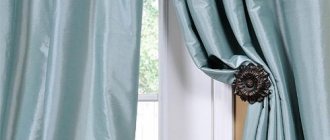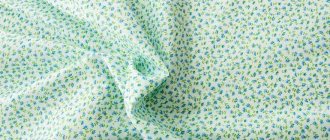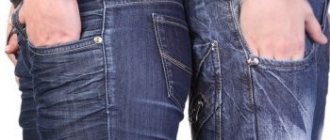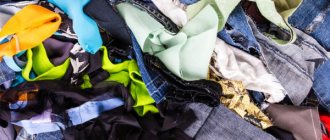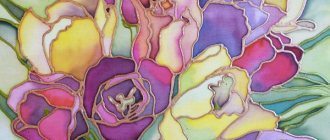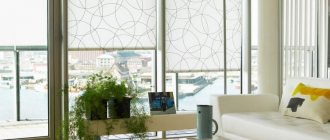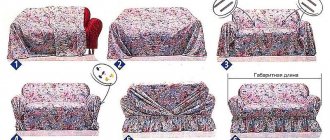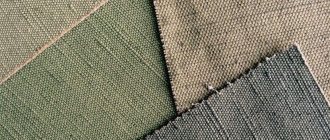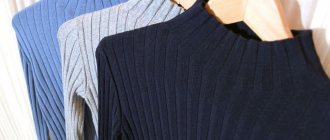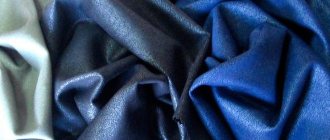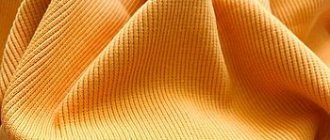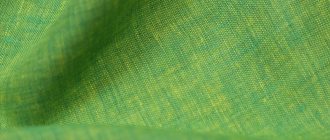Knitted weaves, production principle and classification
Knitted fabric is made by forming loops of threads and interweaving these loops. Unlike fabrics, the production of which requires two systems of threads - warp and weft, crossing at right angles, for the production of knitwear one system of threads is enough. This can be a system of transverse threads forming a woven knitwear (or cross-knitted) or a system of longitudinal threads - warp knitwear (Fig. 1).
Rice. 1
| a — cuffed knitwear b — warp knitted knitwear |
The main elements of knitted weaves are loop, draft and broach (Fig. 2). Loops located horizontally form a loop row, and loops located vertically form a loop column.
Rice. 2
| a - loop b - sketch c - broach |
The most important working part of any knitting machine is the needle. On sewing machines, the thread is laid on each needle sequentially. In Fig. Figure 3 shows a reed needle used on flat knitting machines.
| 1-hook 2-axis 3-tongue 4-extender 5-rod 6-heel |
| Rice. 3 |
The process of looping on reed needles is shown in Fig. 4. When the needle is lifted, the old loop opens the tongue and moves, sliding along the tongue, onto the rod. Thus, the conclusion operation is carried out. The old loop must be pulled back so that when lowering the needle it does not fall on the tongue (in this case the tongue will not close and the loop formation process will be disrupted). The old loop should fall under the open tongue when lowering the needle. The tab will close, i.e. the pressing operation will be carried out - closing the entrance to the needle hook. Before closing the tongue (before pressing), a thread must be laid on the needle so that a new loop is formed from it. The thread should be laid below the hook. This is the operation of threading. As the needle is further lowered, the thread falls under the needle hook (removal), at the same time the old loop moves along the closed tongue, i.e. the application operation is carried out. The old loop approaches the thread, and the joining operation occurs. Then the thread is bent (cutting) and the old loop is dropped. After dropping the old loop, the needle continues to lower to draw a new loop through the old one (shaping operation). Then the needle rises up, while the old loops are pulled back. This is the last tenth looping operation.
Rice. 4
The considered method of loop formation is called knitting. There is also a knitting method, in which culling is carried out immediately after laying the thread. To obtain press drafts on flat knitting machines, the “without conclusion” method is used. The needle rises to a level at which the old loop still remains on the tongue, and in this position receives a new thread. In this case, the old loop is not thrown off the needle: the loop and the sketch remain under the hook. After this, the looping process proceeds normally. It is possible to form several patterns on one needle.
Loop formation when knitting on a flat machine requires the interaction of the needle bar and carriage with the working parts (reed needles and thread guide). The needle bar is used to place and guide the needles. The needle grooves are located at the needle pitch distance t. At the upper edge of the needle bar, the groove widens; when culling and dropping, the loops are tightened there. The narrow part of the shtey is a breaker ridge necessary for loop formation. The striker tooth protrudes slightly above the upper edge of the needle bar. The carriage on the lower surface facing the needle beds carries locks that drive the reed needles. The reciprocating movement of the carriage requires a symmetrical construction of the lock. The closing wedge for carrying out the closing operation may have the shape of an equilateral triangle. The wedge for lowering the needles - the wedge wedge - can also have the shape of a triangle, but since one side of this wedge is needed, its shape can be simplified, thereby reducing the dimensions of the locking system. Thus, to obtain a stockinette stitch on one needle bed, three parts are needed: a closing wedge and two wedges. To produce an eraser, such a lock must be on each needle bed. The working strokes of loop formation are changed using the lock wedges. When the heel of the needle is in the working area of the lock, the needle can occupy three positions:
1. the position in which the loop is formed (full confinement) 2. the position in which the cast is formed (incomplete confinement) 3. the position of non-knitting (idling).
This corresponds to various design solutions: rotating parts of the lock and parts of the lock, adjustable in height above the needle bar (Fig. 6). Wedge wedges set the depth of retraction (lowering) of the reed needles and thereby the density of the knitwear.
Rice. 6
| 1 — wedge of incomplete confinement 2 — wedge of complete confinement 3 — wedge of incomplete confinement |
Geometric parameters of knitwear
The structure of the loops is characterized by the following geometric parameters: The length of the thread in the loop L is the average length of a piece of thread in mm used to form one loop of knitwear. The length of the thread in the loop is related to the depth of culling . The culling depth shows how far the thread goes down between the teeth of the breaker comb. The greater the depth of culling, the greater the length of the thread in the loop and vice versa. The thickness of a textile thread is characterized by the linear density of the thread T, tex (g/km). Tex is the mass of one kilometer of thread in grams. An important parameter of knitwear is the surface density - the weight of 1 square meter. m of knitted fabric, expressed in grams. The horizontal density Pg shows the number of loop columns contained in a segment equal to 100 mm across the width of the knitwear. Vertical density Pv shows how many loop rows are contained in a segment equal to 100 mm along the length of the knitwear.
Classification of knitwear weaves
Weaves are divided into main and patterned. main class includes the simplest weaves, consisting of identical structural elements (loops). Weaves formed from a combination of several identical main ones, mutually knitted so that between the loop columns of one there are loop columns of another, are called derivatives . The class of patterned weaves includes those produced on the basis of the main ones by introducing additional elements into them (sketches, broaches, additional threads) or by changing the production processes. Each patterned weave can be developed on the basis of different main ones. Weave repeat is the smallest part of the pattern, periodically repeating in shape, color and composition of loops. A sufficient idea of the composition and alternation of knitwear loops is given by its graphic recording. In the graphic recording of knitwear, the laying of the thread during the formation of weave repeat is conventionally shown.
Cooking surface
| Scheme | Graphic recording |
Rice. 7
Derivative surface
| Scheme | Graphic recording |
Rice. 8
Eraser 1+1
| Scheme | Graphic recording |
Rice. 9
Eraser 2+2
| Scheme | Graphic recording |
Rice. 10
Patterned weaves and their production
The basis for obtaining patterns in the knitting process are the main weaves (satin stitch, eraser) and their derivatives. A pattern on knitwear can be created by changing the color of the loops in the weave in a certain sequence by alternating multi-colored loop rows or multi-colored loops within one row; the structure of loops by introducing broaches, outlines, double loops, etc.; orientation of the loops relative to the loop columns by crossing the loops. Let's look at getting some patterned weaves.
Press weaves
Weaves, which include sketches doubled with closed loops, are called press weaves. Press weave can be obtained on the basis of any main one. In Fig. Figure 11 shows a diagram and graphical record of press weave based on satin stitch.
| Product type | Drawing diagram | Graphic recording |
Rice. eleven
To obtain a press sketch, it is enough to raise the needle to the level of incomplete conclusion. Thus, in the process of knitting row 1, needles 2, 4, 6 will rise to the level of full enclosure and form satin stitches. Needles 1, 3, 5, 7 will rise to the level of incomplete conclusion, the trajectory of their movement will be different. On row 2, needles 1, 3, 5, 7 form stitch stitches, and on needles 2, 4, 6, outlines are formed.
Jacquard weave
Weaves in which rows of loops are knitted from several threads under the condition of selective formation of loops with each thread are called jacquard. Depending on how many threads of different colors are involved in knitting, jacquard weaves are called two-color, three-color, etc. Jacquard weaves can be single or double. Weaves consisting of loops that are approximately the same size and shape on one side of the knitwear are called regular. Each stitch row is knitted from the same number of threads. Rows of irregular weaves are formed by different numbers of threads, the loops on one side differ from each other in size and shape. Based on the structure of the reverse side, double weaves are divided into complete and incomplete. In full weaves, the thread is knitted on all the needles of the second needle bed. A distinctive feature of full double weaves is horizontal stripes on the reverse side of threads of each color. In incomplete weaves on the wrong side, the thread is knitted through a needle. The reverse side is usually variegated.
Two-color full jacquard
| Product type | Graphic recording |
| Drawing diagram |
Two-color half-length jacquard
| Product type | Graphic recording |
| Drawing diagram |
Weaves with loop transfer
Combined weave
| Product type | Graphic recording |
| Drawing diagram |
Openwork weave
| Product type | Graphic recording |
| Drawing diagram |
Weave with arans
| Product type | Graphic recording |
| Drawing diagram |
Methods for producing outer knitwear
In the production of outer knitwear, 3 methods of making products are usually used:
Semi-regular - the details of the product are knitted along the contour, only the shoulders, sometimes the armhole and neckline are trimmed, then the product is sewn on specialized equipment.
Regular (Fully Fashion) - the details of the product are knitted completely along the contour, there is no undercut. The parts are stitched using chain stitch machines. The regular method is economical in terms of material consumption, but the most labor-intensive.
Knit and Wear – the knitting machine produces a completely finished product that does not require sewing operations. With this method, manual labor is minimized, the product is obtained without seams, but the development of such products is usually more difficult than when knitting along a contour.
To develop knitting programs for the production of knitted products, specialized software is used, for example, M1PLUS for flat knitting equipment from STOLL
Knitted weaves are divided into three groups:
KNITTING GOODS
Knitwear
- a flexible and durable knitted fabric or product consisting of loops intertwined in the longitudinal and transverse directions. Knitwear has a high level of consumer properties: beautiful appearance, comfortable to wear, fits the figure well, and does not restrict movement. All this determined the steady demand for products made from them, as well as the areas of their use.
KNITTING WEAVES
Knitwear consists of a large number of loops connected to each other. Loops located across the fabric in one row form loop rows
, and the loops strung one on top of the other along the knitted fabric are
loop columns.
The order of the loops in knitted fabric is called knitted weave.
According to the method of formation, knitted fabrics are divided into cross-knitted (waist) and warp-knitted.
Cross knit
(knitwear) knitwear is formed from one thread, the loops of the knitwear are straight and can easily unravel vertically and horizontally.
This knitwear is elastic in the transverse direction and retains its shape well during wear. In the loops of cross-knitted knitwear, loop arches
and
loop sticks are distinguished.
Warp knitted
In knitwear, each loop of the buttonhole row is formed from its own separate thread.
To obtain a loop row, you need as many threads as there are loops in the row. To cross-link the loops, the threads, having formed a row, are shifted one needle to the right. Warp knitted fabric has slanted loops, low stretch, does not unravel horizontally and very little vertically. In warp knitted knitwear, a distinction is made between the core of the loop
and
the broach.
Knitted weaves are also divided into:
- single (loops are arranged in one row)
- double (loops are arranged in 2 rows)
Knitted weaves are divided into three groups:
1. The main weaves have the simplest structure, consisting of identical loops (satin stitch, eraser, double purl, chain, tights, satin).
The main transverse weaves are knitted.
Surface
- This is a weave where the front and back sides are different from each other. There are loop sticks on the front side, and loop arcs on the back side. The smooth surface unravels easily, has good stretchability, and curls at the edges.
Eraser
- weave with the same front and back sides, where columns of loop sticks alternate with columns of loop arcs. The alternation of columns can be different: 1+1, 1+2, 2+2, etc. It has good stretchability in the transverse direction, less unraveling, no curling, unraveling in the opposite direction to knitting.
Double purl
– the weave has the same structure on the front and back sides and consists of looped arcs. It has stretchability in all directions, does not curl, and unravels easily.
Transverse derivatives are knitted weaves.
Derivative surface
- double weave obtained by combining two satin stitches knitted into each other. Both sides of the board have the same appearance. The fabric is dense, does not stretch much in length and width, and does not unravel well. Used for making thin knitwear with a smooth surface and limited stretch.
Interlock
- a double eraser, formed by the combination of two erasers tied into one another. The front and back sides are identical and consist of facial loops, the centers of which coincide on both sides of the fabric. The fabric has low elongation and unraveling, is denser than an eraser, and does not curl.
Patterned weaves.
Plated (cover)
- weave is characterized by the fact that two threads, different in fiber and color, are knitted into one loop, as a result of which the loops are arranged in two layers: one thread goes to the front side, the other to the back. Plated patterned knitwear is produced by alternately changing the front and back threads according to a specific pattern.
Plush -
is produced from two threads, one of which forms the ground of the fabric (short loops), and the other forms the plush covering (long loops). The pile is made from uncut loops, can be located on the front or back side, and can also be double-sided. Used in the manufacture of hosiery, outerwear and underwear.
Lined (combed) -
It is made from two threads, a ground thread and a thicker lining thread. The weave has a one- or two-sided pile surface formed by combing an additional knitted thickened thread. It has increased heat-protective properties and is used in the production of warm underwear and outerwear.
Fang (press)
- obtained on the basis of an eraser by alternating knitted knit stitches and press loops
(unknitted purl loops with a yarn over).
Both sides of the fabric are the same and look like an eraser, but the purl loops are clearly visible even without stretching the fabric across the width.
Half-fang (press)
- press weave, in which loop columns with press loops alternate with loop columns of satin stitch. The canvas resembles an eraser, but on one side it has a more elongated shape of facial loops.
Compared to an eraser, fang and semifang have less elongation but greater thickness.
Jacquard –
It is distinguished by the presence of a colored or relief pattern on the front side of the fabric. There are single and double jacquards. Single: has a small pattern on the front side, and colored threads on the back side. Double: has a large colored pattern on the front side, and loops of different colors on the back.
Jacquard fabrics have low elongation and unraveling, increased thickness and weight. They are widely used in the production of outerwear, hosiery, hats and gloves.
Openwork –
cross-knitted weave is obtained by transferring loops from one loop column to another, as a result of which holes are formed in the fabric, forming a certain pattern. It is characterized by good translucency, low weight, and bloomability.
Sirloin
- a warp weave in which there is no connection between some adjacent stitches in one or more rows, resulting in holes of various shapes and sizes. Used in the manufacture of summer gloves, dresses, sweatshirts, and finishing parts.
Linen products.
Assortment of men's underwear: overshirts, sweatshirts, long johns, T-shirts, briefs.
Sweatshirt
- a product with or without a fastener, with long or short sleeves, worn directly on the body.
Pants
- belted men's clothing, covering the lower part of the torso and legs to the feet, worn directly on the body.
Mike
- a product without sleeves and fasteners, worn directly on the body.
Underpants
- waist clothing covering the lower part of the body and the upper part of the legs, each individually worn directly on the body.
Assortment of women's underwear: nightgowns, slips, pantaloons, negligees, petticoats.
Nightgown
- Shoulder sleepwear worn directly on the body.
Peignoir
- elegant women's clothing with a slit or fastening from top to bottom, worn as sleepwear.
Combination
- an elegant shirt worn over underwear.
Petticoat
- waist-length women's clothing of various lengths, worn under a skirt or dress.
Trousers
– panties with legs
(long, short),
can have different finishes.
Bodysuit
- a product for women and girls, a tight-fitting body, consisting of a bodice with sleeves (or sleeveless) and panties, combined into one piece and worn over corsetry or directly on the body.
The range of children's knitted underwear can be the same as the range of sewing products.
3. Hosiery.
The range of hosiery products includes stockings, half-stockings, socks, tights, underwear, leggings, etc.
The dimensions of hosiery are determined by the length of the trace in centimeters:
children's stockings and socks - from 12th to 22nd;
half-stockings for children - from 14th to 22nd;
men's socks - from 21 to 31;
Stockings, half-stockings, women's socks - from 21 to 29 sizes.
The sizes of women's tights made of elastic threads are indicated in a conventional system - from 1 to 7 (determined depending on the weight and height of the consumer)
, children's tights - by track length and height.
Assortment of hosiery products.
Followers
– products for women and girls that completely cover the feet.
Half-successors
cover the fingers and part of the feet.
Socks
– products covering the feet and lower part of the legs, including the ankle (or ankle and part of the calf).
Half stockings (knee socks)
cover the feet and lower legs up to the knee.
Stockings
cover the legs and part of the thighs.
A women's stocking consists of a side, a leg, a heel, a trail and a toe.
Bead - the upper part of the stocking, 5 - 9 cm high, can be trimmed in the form of lace.
Leg cap - covers the leg from the knee to the foot.
Heel - covers the heel of the leg and part of the lower leg, can be high - up to 12 cm and low - up to 4 cm.
The footprint is the part of the stocking that covers the top and bottom of the foot.
The toe is the final part of the footprint, covering the fingers.
Women's stockings are produced in a molded form (they have the anatomical shape of the leg)
and unmolded.
Tights
- a pair of stockings connected to each other by underwear, tightly fitting the legs from the feet to the waist.
Women's tights have a collar, gusset, legs, heel, footprint, and toe.
According to the manufacturing method, tights can be seamless knitted (regular)
and cut, with a gusset
(a part that is located in the crotch between two stockings, it increases the comfort and hygiene of tights, increases their durability
.
)
or without it.
According to the finishing method - molded (replicating the anatomical structure of the leg)
and unmolded.
Tights are made mainly from nylon threads and elastane (lycra),
which creates elasticity in tights and a good fit on the leg.
The density of tights is indicated in den - a unit of linear density, which indicates the ratio of the mass of fibers or threads to the length (weight of fibers in grams per 9 km of thread). As the den , the density of the tights increases.
The size of tights depends on height, weight and hip volume. On the manufacturer's packaging there are size plates and pictograms with the design features of the tights ( a model with a gusset, a shaped foot, a reinforced toe, flat seams (not drawn through the dress), a wide belt (the tights do not slip and partially correct the figure), etc. .).
Gaiters
– stockings or half-stockings that do not cover the feet.
Gloves.
Gloves are divided into sewn and knitted; winter, demi-season and summer; men's, women's, children's.
The dimensions of gloves are equal to ½ the circumference of the hand in centimeters, between the bases of the thumb and index fingers.
Mittens
- a product that partially covers the forearm, the palm of the hand, four fingers together and the thumb separately, or three fingers together, and the thumb and index separately.
Gloves
- a product that covers partially or completely the forearm, the palm of the hands and five fingers, each individually.
Mittens
– a product that partially covers the forearm, palm of the hand and five fingers together for newborns and nursery children.
5. Hats and scarves.
The range includes hats, berets, caps, scarves, scarves, headscarves, stoles, headsets, etc.
Handkerchief
– a product for women or girls in the shape of a square.
Kerchief
– a triangular-shaped product.
Scarf
- a rectangular product.
Stole
– a scarf 1.5-2 m long and at least 50 cm wide.
Set
– combines various products, united by finishing and raw material composition.
QUALITY REQUIREMENTS FOR KNITTING PRODUCTS
Clothing quality control means checking the compliance of product quality indicators with the requirements set out in GOSTs. and TU.
The design of the outer knitted products should be comfortable, shape-resistant, the coloring should be durable, and the quality of workmanship should be high. Linen products must have a high level of hygienic properties. Hosiery must retain its dimensions during wear, have good elongation and abrasion resistance
The quality of clothing is checked by external inspection from the top and back by measuring the linear dimensions of products (width, length, etc.) and their finishing units and parts. The objects of control are the appearance of the product, the quality of its fit on the figure and the quality of processing.
Knitted products are classified as 1st or 2nd grade. When determining the grade, the size of the defect, its location on the product, and their total number are taken into account.
KNITTING GOODS
Knitwear
- a flexible and durable knitted fabric or product consisting of loops intertwined in the longitudinal and transverse directions. Knitwear has a high level of consumer properties: beautiful appearance, comfortable to wear, fits the figure well, and does not restrict movement. All this determined the steady demand for products made from them, as well as the areas of their use.
KNITTING WEAVES
Knitwear consists of a large number of loops connected to each other. Loops located across the fabric in one row form loop rows
, and the loops strung one on top of the other along the knitted fabric are
loop columns.
The order of the loops in knitted fabric is called knitted weave.
According to the method of formation, knitted fabrics are divided into cross-knitted (waist) and warp-knitted.
Cross knit
(knitwear) knitwear is formed from one thread, the loops of the knitwear are straight and can easily unravel vertically and horizontally.
This knitwear is elastic in the transverse direction and retains its shape well during wear. In the loops of cross-knitted knitwear, loop arches
and
loop sticks are distinguished.
Warp knitted
In knitwear, each loop of the buttonhole row is formed from its own separate thread.
To obtain a loop row, you need as many threads as there are loops in the row. To cross-link the loops, the threads, having formed a row, are shifted one needle to the right. Warp knitted fabric has slanted loops, low stretch, does not unravel horizontally and very little vertically. In warp knitted knitwear, a distinction is made between the core of the loop
and
the broach.
Knitted weaves are also divided into:
- single (loops are arranged in one row)
- double (loops are arranged in 2 rows)
Knitted weaves are divided into three groups:
1. The main weaves have the simplest structure, consisting of identical loops (satin stitch, eraser, double purl, chain, tights, satin).
Interlock - what kind of fabric, composition, properties, advantages and disadvantages
Interlock is a natural cotton double knit that looks the same on both the front and back. Translated from English, interlock means “crossing, overlapping.” Indeed, interlock is recognized by the special dense and dense weave of threads “in an elastic band”, which is formed during knitting of the fabric.
This is a modern fabric, soft and durable, which is used for sewing children's clothing, linen and other delicate items. It is preferred by people who care about health and love comfortable sensations on the body. It is more correct to call interlock (like any other knitwear) not fabric, but linen, since it is not woven, but rather knitted (knitwear from the French tricotage - knitted products). We will look at what kind of interlock fabric this is and what its advantages and characteristics are below.
Manufacturing technology
Interlock is formed by erasers connected to the reverse side (light satin weave), so the reverse side cannot be distinguished in the fabric. Due to the identical surface on either side, this material is also called dual-elastic.
When making fabric, the threads are intertwined and connected, bending into loops. Preliminary preparation of threads is also very important for the production of high-quality material. They are treated with paraffin and emulsion for smoothness and strength.
Typically, interlock is made using special machines - these are knitting machines with two needle beds fixed at a special angle.
To make striped and checkered patterns, threads of different colors are initially used. Finished canvases are dyed using the printed method: each color separately. To dye colored fabric or prepared bleached fabric, designs are printed using the direct method - dyes are applied only to certain areas required by the pattern.
Properties and features of fabric
Thanks to their natural composition, interlock products fit comfortably to the body and allow the skin to “breathe”. The fabric is very light, weightless and perfectly warms, especially at home. Fabric density ranges from 180 to 330 g/m².
Interlock can be painted in any colors, bright or pastel, with prints and patterns, which allows the material to be used for any clothing design.
Other advantages of interlock include:
- durability - the fabric can withstand long-term use, mechanical washing, and daily wear;
- preservation of shape - the material is elastic and recovers after stretching, and also generally has poor stretch, the threads do not unravel or stretch;
- color fastness - the fabric does not fade or fade;
- environmental friendliness - natural materials are used to make interlock;
- safety for health - natural fabric is breathable, does not cause irritation, absorbs moisture, is suitable for delicate and sensitive skin, especially children's;
- thermal insulation - interlock retains heat perfectly and helps maintain a comfortable body temperature, while air can circulate freely and a person will not overheat;
- durability - clothes made of this material can be worn for a long time without fear of puffs and other damage to the fabric;
- softness - the fabric is pleasant to the touch, smooth and elastic, even after washing;
- Easy to care for - just follow the recommendations on the product label.
Interlock has very few disadvantages:
- slight elasticity;
- The product may shrink in length after washing.
Types of material
Interlock is divided into three types of fabric according to density, surface texture, level of fiber processing, that is, according to the overall quality of the fabric and appearance. High quality fabric is determined visually by its smoothness, the absence of protruding fibers and various deformations.
- Peña is an interlock of the first category, the best fabric. The canvas is very dense, smooth, without flaws, irregularities, pellets and fibers, it seems polished. The products look durable and solid. This type of fabric is suitable for sewing elegant clothes: shirts, dresses, blouses.
- Ring (carde) is a medium quality material. The fibers of the fabric are looser, but still smooth. This fabric is not as dense as foam. Pre-bed linen, T-shirts and tank tops are made from the ring, because such fabric is practically not felt on the body.
- Oppenend is a soft, loose and fleecy fabric of low quality. Irregularities of fibers and roughness are allowed. Openend is used to make pajamas, home suits, and pants.
There are also similar fabrics that have similar properties, but are not interlock. Knowing about the existence of these materials will prevent you from making mistakes when purchasing:
- cashcorse - cotton fabric of the same density with interlock, which contains about 10% elastane or polyester;
- kulirka (suprem) - cotton fabric with 10% lycra or polyester in its composition, it is less dense than interlock;
- footer is a smooth and warm fabric with the addition of wool, lycra, polyester and brushed on the reverse side, denser than interlock.
What is sewn from interlock?
Pleasant to the touch and warm material is ideal for sewing delicate household items:
- children's clothing (rompers, vests, sweaters, pants, booties, hats);
- tracksuits, loose pants, sweatshirts, sweatshirts;
- home pants, T-shirts, turtlenecks;
- soft dresses;
- pajamas, nightgowns and sleeping sets (shorts, T-shirts);
- underwear;
- robes.
Product care
To keep interlock clothing in good condition, hand washing at 40°C will be sufficient. The fabric will retain all its qualities even when washed in a washing machine. In this case, select the “delicate” mode. Powders and liquids with chlorine can damage the material; it is better to use mild products.
The use of conditioners or rinse aids is at your discretion, but with these products the fabric retains its softness longer after washing. The material can be gently wrung out both by hand and in a machine. Dry the products in the usual way.
Interlock is an affordable, practical and beautiful fabric. The material is ideal for sewing household and children's items, as well as for people with sensitive skin who cannot tolerate synthetics. Interlock products are very easy to care for, they are soft, light, warm and smooth. Clothing made from this fabric lasts a long time and retains a beautiful, aesthetic appearance.
The fabric catalog on our website presents a wide range of knitted fabrics of our own production. We offer our customers knitwear of the highest quality and favorable terms of cooperation. To buy interlock knitted fabric wholesale or small wholesale from 1 roll, you can leave an online application on the website, send your order by email [email protected] or call the contact number (8-800-505-06-14, free in the Russian Federation ).
Source: textile.life
Knitted fabrics: classification, properties and external distinctive features
Knitwear is a material obtained from threads by hand or machine knitting and consisting of interconnected loops. Unlike fabrics, where the threads are fixed quite rigidly, in knitwear the threads that form the loops are in a looser state. Thanks to this, knitwear has extensibility, elasticity and softness, but low dimensional stability and easy unraveling.
According to the knitting method, a distinction is made between cross-knitted (knitted) and warp-knitted jersey.
The culinary method involves manufacturing the canvas in the transverse direction. Such knitwear can be obtained from one system of threads in the form of fabric, finished product and individual parts. Characterized by easy blooming horizontally and vertically. It is represented by a wide range of fabrics: from thin smooth to voluminous fluffy fabrics and products.
To produce warp knitted fabrics, use a number of thread systems equal to the number of loops in a row (up to several hundred). The fabric is expanded in the longitudinal direction. Warp knitted fabrics are characterized by fineness and smoothness and, unlike cross-knitted fabrics, have less elongation and greater dimensional stability; the fabric is unraveled only in the direction opposite to knitting.
Cross-knitted (knitted) weaves (Fig. 4.4) are divided into the following groups:
- group of main weaves:
The satin surface is characterized by a flat, smooth front surface and a raised, rough back surface, i.e. they differ sharply from each other. It has good elongation, vapor and air permeability. It easily unravels and curls at the edges, which complicates cutting and sewing products;
The eraser is an alternation of vertical knit and purl stitches in various combinations. Distinctive properties include: stretchability in width is greater than in length, high elasticity, less unraveling compared to satin stitch, good dimensional stability. Used for making stand-up collars, wristbands (cuffs), processing collars and hems of products;
- group of derivative weaves:
Interlock is made by cross-weaving two erasers. On the front and back sides, only the front loops are visible even when stretched strongly. Characteristic features of interlock are good dimensional stability, low elongation and unraveling, abrasion resistance, high elasticity and heat protection;
The derivative stitch is an alternation of rows of knit and purl stitches on the front side. The canvases are dense and embossed with identical front and back sides;
- group of patterned weaves:
plated (cover) weaves are produced by simultaneously laying two loops of different colors or fibrous composition, one of which forms the ground, the other the front surface. The canvases have a beautiful appearance;
plush weave is distinguished by the presence of looped or cut pile, thanks to which the fabric has a beautiful appearance, high heat resistance, stretchability and the ability to absorb moisture;
press weaves are created using a loop and yarn over, which allows you to increase the thickness and volume of the fabric. These include fang and semifang. Fang is obtained on the basis of an eraser by alternating knitted stitches and purl stitches not knitted, but with a double crochet, in a horizontal row. Both sides of the canvas are the same. In a half-fang, the front and back sides resemble an eraser, but differ in the shape of the front loops: on the one hand they have a more elongated shape, on the other they have a more rounded shape. Compared to an eraser, fang and semifang have less elongation, but greater thickness, weight and strength;
openwork weaves have a certain pattern formed by gaps that are obtained as a result of knitting. Openwork knitwear is characterized by good breathability, translucency, low weight, unravelability and dimensional stability;
combed (lined) fabrics are made from two threads: the ground thread is knitted through all the loops, and the lining (thicker) is knitted into the fabric in the form of freely sagging pieces of thread. When finishing the fabric, the lining thread is combed and a covering is created on the surface. Distinctive properties are increased density, heat protection, softness, strength and low extensibility;
jacquard weaves are distinguished by the presence of a colored (due to pre-dyed threads) or relief pattern on the front side of the fabric. Characteristic features of jacquard fabrics are low elongation and unraveling, increased thickness and weight, and beautiful appearance;
Combined weaves are obtained by combining different weaves. These include rep, pique, and combined satin stitch. Rep has transverse scars on the front surface, low extensibility and unraveling, and high dimensional stability. Pique is characterized by a small pattern in the form of scales on the front side. It has low stretchability, elasticity and a beautiful appearance.
Warp weaves include the following groups and types:
- group of main weaves (Fig. 4.5):
a chain is a looped column of loops obtained from one thread by laying it on the same needle. It unravels in the opposite direction to knitting and has low stretch. Used as fringe in scarves and shawls, as well as for combination with other weaves;
leotards are made by shifting the vertical stroke of the thread after knitting a loop by one needle to the left or right. It is characterized by greater elongation and unraveling, therefore it is used to obtain combined weaves;
the satin has transverse stripes, which is especially noticeable when using colored threads. Satin is characterized by curled edges, significant stretchability and unraveling;
- group of derivative weaves:
cloth is obtained by knitting loops through one row. On the wrong side of the fabric, the broaches between the loops form a “herringbone” pattern located across the fabric. Compared to tights, cloth is less stretchable and unraveling, but heavier and denser;
charme is made by knitting loops through two rows, so the broaches on the wrong side are longer than those of cloth and form a dense covering. To increase thermal insulation, the resulting covering can be brushed. Charme is heavier and thicker than cloth, but it unravels and stretches less;
- group of patterned weaves:
plated (cover) weaves are obtained by using two differently colored threads: one goes to the front surface of the fabric, the other goes to the back. The most common weaves are tricot - tricot, cloth - cloth, tricot - cloth, tricot - charme, satin - cloth, satin - tricot. They have little stretchability and unraveling, a beautiful appearance;
sirloin is distinguished by the presence of a pattern of holes (of various shapes and sizes) obtained during the knitting process;
jacquard warp weaves have much in common with pattern jacquard according to the principle of pattern formation. Single fabrics are produced with smooth and textured weaves. In raised jacquard weave, raised patterns are made from loops of different lengths.
Rationale for the choice of weave
In order for the product to be light, dense and look great, it is necessary to use smooth fabrics. In this case, you can offer a 1+1 eraser, combined weaves and weave stitch.
Eraser 1+1 is a double two-face weave, in which knit and purl stitches regularly alternate on both sides. The eraser weave is light, smooth and elastic. A positive property of the 1+1 eraser is that it unravels only in the direction opposite to knitting. If the thread breaks in one of the loops, the corresponding loop column unravels only from top to bottom, i.e. in the opposite direction to knitting. A negative property of the eraser is its increased elasticity across the width. The 1+1 eraser stretches almost 3.5 times in width than in length. The elasticity of the eraser across the width is 2 times greater than the elasticity of the surface. Also a negative property is a significant percentage of shrinkage when removed from the machine, i.e. its free width is much smaller than its filling width on the car. The above properties of the 1+1 eraser weave make this weave unacceptable for the proposed model, since it does not have uniform stretchability along the length and width.
Fig. 17 Structure of weave eraser 1+1
Kulirny stitch is a cross-knitted knitted weave consisting of loops that are identical in shape and size. A negative property of the stockinette stitch is its curl. The curl of the satin stitch makes it difficult to sew items from it after cutting. Therefore, before cutting, plain knitwear is ironed or subjected to other types of wet-heat treatment in order to stabilize the loops and reduce the elasticity of the threads. But at the same time, the curl is positive when knitting the trim with double stitch stitch. A positive property of the surface is its beautiful, smooth and even surface. Unlike other weaves, weave stitch has stretchability in all directions, which allows the loops to change shape and size. The loose loop structure gives the knitwear softness and wrinkle-resistance, which makes knitted items made from satin stitch practical and comfortable. Resilience and elasticity help maintain the shape of the product during wear and significantly increase the resistance of products to abrasion and repeated stretching.
Fig. 18 The structure of the weave of the stockinette stitch: a) front side; b) wrong side
Combined weaves - with their help you can achieve all kinds of patterned effects and modify the structure and properties of knitwear. Combined weave knitwear is formed by a combination of main, derivative and patterned weaves. Such combinations can have an unlimited number of options, which depend on the purpose of the knitwear. A positive property of combined weaves is the production of shape-resistant fabrics. A negative property of combined weaves is the large mass of the fabric, but this is not scary, because this model should be denser and not loose, which can be achieved using a combined weave.
Fig. 19 The structure of the combined weave “reps”: a) graphic recording; b) weave structure
Based on the above properties, the combined weave (rep) is most suitable for tunics in the Safari style.
Justification for the choice of raw materials
Based on the proposed model, we can conclude that the product should have the following properties: lightness, smoothness, dimensional stability, strength.
For this case, the following types of yarn are produced: pure wool, mixed (50% pure wool + 50% acrylic) and PAN yarn.
PAN - yarn - belongs to the group of polyacrylonitrile fibers. On the market PAN yarn is known under the names “nitron”, “orlon”, “acrylic” and “prelana”. The main properties of acrylic are strength, light fastness and thermoplasticity. Acrylic fibers are easily dyed, which allows you to get very bright colors of the yarn. Among the main disadvantages of acrylic is low hygroscopicity, which deprives acrylic products of hygienic properties. Another disadvantage is that acrylic products stretch during wear. A characteristic disadvantage is pilling. At the same time, acrylic is well used in finishing, since during the process of wet-heat treatment, lace knitted from acrylic in two threads with the addition of lurex is quite dimensional stable, which is applicable for this model. Pure wool is a natural fiber. Synonyms for wool include words such as “care, warmth and softness.” Among the general properties of wool, it is necessary to note the unique ability to retain heat. The wool has good stretch and is resistant to creasing. Serious disadvantages of wool are felting and the formation of pilling during friction, which depend on the tightness of the yarn twist (the lower the twist, the more felting). Also, the main disadvantage is shrinkage during washing, which leads to a significant distortion of dimensions, therefore dry cleaning is recommended for products made from pure wool yarn. Considering the above, we can conclude that pure wool is not recommended for this product.
Blended yarn (50% pure wool + 50% PAN yarn) - this mixture is widely used nowadays. Such yarn becomes cheaper than pure wool. Knitted products made from mixed yarns are quite elegant, durable and shape-resistant. Finished products, due to the special twist of the yarn, keep their shape well. Blended yarn retains heat well and also regulates the difference between body temperature and air temperature. This yarn is very practical to wear. You can knit any type of weave and on any equipment. The linear density of yarn depends on the choice of model and class of machine. This model is knitted on a class 10 machine. You can process yarn with a linear density of up to 300 tex. The product is knitted from mixed yarn using a combined weave. The greater the linear density, the greater the density of the fabric. Therefore, in order to obtain a light and dense product and less waste, it is necessary to use 31x2 tex yarn. Twisted yarn is easier to process, so it is necessary to take yarn with a linear density of 31x2 tex for strength, minimal waste, better processing ability and high productivity. Based on the above properties of mixed yarn, we can conclude that it is mixed yarn (50% pure wool + 50% acrylic) that is recommended to be used for knitting this product.
TRIKOTAZHA.NET
Single jersey
Single knitwear is called knitwear, which is produced on machines with one needle bed. Single knitwear can be knitted or warp knitted. Single knit weaves can be main or derivative. The main weaves include: stockinette stitch, chain, leotard, satin, and derivatives include derivative satin stitch, derivative leotard, derivative satin, etc.
Satin stitch is a single weave, the loops of which are formed by thread sequentially along the loop rows. The satin surface is widely used for linen, hosiery and sportswear.
In satin stitch, you can easily distinguish the front side from the back side. On the front side, longitudinal stripes of loop columns are visible, and on the back side, arcs of loops are visible, between which sticks can be seen in loose knitwear.
The wrong side of the satin stitch will appear darker than the front side, since the arcs of the loops on the wrong side, due to their greater curvature, scatter the rays of light more than the sticks of the front side.
If you cut a quadrangle from a piece of knitwear knitted with satin stitch along the stitches and loop rows, then, having freed the edge loop rows from the ends of the threads, it can be unraveled by pulling the top loops from the previous row or the bottom ones from the loops of the next row, i.e. in the knitting direction and in the opposite direction.
If the satin stitch is knitted in the form of a strip, then it cannot be unraveled in the direction of knitting, since the thread will be delayed in the edge loops.
If one loop breaks in a piece of satin stitch that is in a stretched state, then the loops will unravel from the broken loop along the line of the stitch stitch in the direction opposite to the knitting.
To reduce the unraveling of the satin stitch, it is necessary to: reduce the length of the loop with the same thickness of yarn or increase the thickness of the yarn with the same length of loop, increase the coefficient of friction of the thread on the thread, using yarn from fibers with an increased coefficient of friction.
Single yarn used in knitting production can be right-handed or left-handed. Elastic deformation forces tend to unwind the yarn. Therefore, loops formed from a single thread of right-hand twist will rotate clockwise under the influence of these forces. As a result of this, knitwear made from right-twist yarn will have stitch stitches tilted to the left towards the line of the loop row, and knitwear made from left-twist yarn will have the row line straightened, i.e. the knitwear will be skewed.
In a stocking knitted with satin stitch from a single thread with an increased right or left twist, the stitches will be located along a helical line, and a correctly put on stocking will twist along the leg, and the trace will twist so much that the heel will turn relative to the toe at a significant angle.
When straightening the knitwear during finishing, the distortion of the loop columns is eliminated, but after washing the distortion is restored and the product loses its shape.
To eliminate these shortcomings, knitwear is produced from yarn with a balanced twist, that is, from yarn twisted from two threads with opposite twist, or from a single thread with a weak twist.
The surface tends to curl at the edges. This phenomenon is caused by the elasticity of the yarn, bent in the loops and tending to straighten. The curl of the satin stitch at the edges increases with an increase in the elasticity of the yarn, an increase in its text and a decrease in the length of the loop.
This property of the surface makes it difficult to manufacture products. To prevent the edges of the stitched parts from curling, the knitted fabric should be subjected to wet heat treatment before cutting.
However, such fixation of the shape of the loops is temporary for all types of yarn, except synthetic. During wear and after washing, knitwear regains the ability to curl.
Chain is a warp-knit single weave, the loops of which are formed by one thread and form one loop column. The chain does not twist, since the curved sections of the sticks of each loop are balanced by a broach that has the opposite bend.
The elongation of the chain in the longitudinal direction depends on the elasticity of the yarn from which it is knitted. The more elastic the yarn is, the more rounded the shape the loops take, therefore, the greater the elongation of the chain will be due to the straightening of the curved sections of the thread forming the loop.
Chains connected with high density or from low-elastic threads are almost not stretched in the longitudinal direction.
Entering as an element into any weave, chains reduce its elongation in the longitudinal direction. Chain weave is used to produce nets, curtains and fringes.
Tricot is a single warp knitted weave, the loops of which are formed by the same thread and are arranged alternately in two adjacent loop columns. A characteristic feature of this weave is that all its loops have broaches extending from the loop in one direction. In this case, the angle formed by the broach with the stick entering the loop is greater than the angle formed by the broach exiting with the loop stick. As a result, the tendency of the thread to straighten will be greater in those areas where the thread is more curved, i.e. in this case, sticks with an outgoing broach will unbend with greater force than sticks with an incoming broach. And since both broaches have a bend in one direction, opposite to the bend, the broaches, located in the loop arc one above the other, will turn the loop arcs into a plane perpendicular to the plane of the knitwear. As a result, both sides of the leotard weave structure will have the same leotard appearance. The combination of inclined loops with broaches forms a mesh in a rare leotard with cells limited on one side by loops and on the other by broaches.
If you stretch the tights in length, the loop columns will come closer together.
Tricot, like all warp weaves, unravels only in the direction opposite to the knitting.
If the top loop of any loop post of a cut-out section of leotard is freed from the ends of the threads and pulled wide, then this loop will slip out of the previous loop, the second loop will slip out of the next one, etc. As a result, the cut-out section of the leotard fabric will be divided along the line of the loop post.
Therefore, when cutting out parts from tricot weave fabric, you need to remember that you should not clean the edges of the cuts from threads, as they keep the parts from unraveling.
When removing such knitwear from the machine, it must be cut along the last loop row so that the ends of the threads remain in the loops.
When a single loop in the fabric breaks, as well as when the torn ends slip out of the previous loop, the tights may unravel along the loop column. This is a major drawback of leotards, especially those knitted from rayon, which have a thread-to-thread friction coefficient that is half that of cotton yarn.
Unlike satin stitch, leotard does not curl at the edges, which makes work easier when making products.
Satin is a warp-knit weave in which each one sequentially forms loops in many stitches. As a result, the satin has loops with one-sided, as in tights, and two-sided broaches. The appearance of satin weave knitwear can be different, depending on the number of loops with double-sided broaches available in repeat 1 weave.
The weave repeat in this case is equal to 4 loop rows. In reality, depending on the elastic forces and the direction of the broaches, the satin loops will have different inclinations.
In the satin, loops with one-way broaches will turn in the direction opposite to the broaches, and loops with double-sided broaches will turn in the direction opposite to the broach, which has a greater bend.
Obviously, the inclination of loops with one-sided broaches will be greater than the inclination of loops with double-sided broaches.
Depending on the rapport of the atlas, rows of loops with different slopes will alternate in different sequences.
Rays of light falling on such a canvas will be reflected differently from the surface of the loop rows, creating the impression of stripes. In addition, rows I, III, V of turning loops in the satin will be more convex and noticeable on the surface of the canvas.
An atlas is called simple if its loops, formed by one thread, are located in several loop columns
in one direction and then in the same loop columns go in the opposite direction to the original loop column.
A complex atlas is one in which rotary loops are formed through a different number of loops with different broaches. At the same time, weave repeats can be very diverse.
If you look at the satin between the rows with rotary loops along the line of the loop columns, you will notice that it is no different from a simple satin stitch.
Satin, like satin, tends to curl at the edges. The satin unravels only in the direction opposite to the knitting if all the warp threads have a strong and equal tension. When a single loop breaks, it unravels along the loop column from the broken loop in the direction opposite to the knitting.
The unravelability of satin decreases with increasing frequency and coefficient of friction of the threads, as well as with increasing yarn elasticity. Knitwear obtained by weaving satin is used to make underwear, blouses, etc.
Derived satin stitch is a single weave formed from two weaves of satin stitch, knitted into each other so that between the loop stitches of one satin stitch are the loop stitches of the other. Thanks to this structure, it can only be unraveled from above in the direction opposite to knitting. If you try to unravel a derivative stitch from below, the threads of one weave of the satin stitch will be delayed by the loops of the other weave of the satin stitch, they will tighten, and there will be no unraveling. If, while pulling the threads from above, you unravel one stitch, then the other stitch will remain unraveled with wide spaces between the loop stitches.
If the thread breaks, the derivative stitch, which is in a stretched state, will be more difficult to unravel than the usual one, due to the friction of the broaches of one stitch on the loops of the other, and also because the tensile force will be hampered by the frame of the remaining intact stitch. This property is important when producing artificial silk derivatives, which have a low coefficient of friction.
The unravelability of the derivative satin stitch decreases with increasing knitting density, increasing yarn thickness and using yarn with a high coefficient of friction.
Derivative satin stitch, just like regular satin stitch, tends to curl at the edges. To eliminate this phenomenon, the loops should be heat-fixed before cutting.
Derived tights are weaves formed from several weaves of tights so that between the loop columns of one weave the loop columns of another or several weave tights are placed.
In the case when the columns of another tights are placed between the loop columns of one tights weave, the jersey of such a weave is called three-needle, or cloth.
If loop posts of other tights are placed between the loop posts of one tights, then the latter can be four-needle, five-needle, etc.
As can be seen from the diagram of the structure of a three-needle leotard, the broaches in each weave of the leotard, moving from one loop to another, cross the loop of another weave from the inside out. The thread of the loop in the places of transition from the sticks to the broaches has a greater bend, and since the broaches are one-sided, they give the loop a tilt under the influence of an elastic force equal to the sum of the elastic forces of the two broaches. Therefore, the loops in the posts have a zigzag slope, which gives the front side of the cloth an unsightly appearance. At the same time, the broaches of the cloth on the wrong side create the impression of straight loop stitches on the front side, directed perpendicular to the actual loop stitches.
Such a fabric is unraveled in the direction opposite to knitting, provided that all threads are tensioned uniformly at the same time.
If a single loop breaks in the middle of the fabric, the loop column, when stretched, will unravel from the broken loop, but less than in a regular tights, since the load will be taken by the second tights, which becomes the frame. Consequently, the cloth has increased resistance to unraveling when a loop breaks, which is its valuable quality.
The knitting industry, using this quality of leotard derivatives, produces products from multi-needle leotard fabric, i.e., weave, obtained as a result of a multiple increase in the number of main leotard weaves included in the leotard derivative. This fabric has low elongation both in width and length, a large weight of 1 m2, less unraveling when loops break, has a more shiny surface on the wrong side and a uniform structure of loop columns with rounder loops on the front side.
Multi-needle leotard is convenient for mass sewing of knitted products, since it can be used on both sides (it is double-sided) and the parts can be cut in the transverse direction.
Derived atlas - weaves in which two or more atlases are combined, so that between the loop columns of one atlas there are loop columns of one or more other atlases.
The broaches of one satin included in the weave cross the loops of other satins on the wrong side.
The inclinations of the loops of the satin derivatives are somewhat less than the main one, since the threads have longer broaches and less bending when the broach passes into the stick.
Cloth satin, like all satin derivatives, can unravel in the direction opposite to knitting, provided that all threads are evenly tensioned. When a single loop breaks during stretching in a derivative satin, the entire loop column unravels, but the unravelability of cloth satin, like all derivatives, is much less.
Thanks to longer broaches, the derived satin (as well as the derived leotard) has less stretch in length and width, which makes it easier to cut and sew products from such fabric.
Source: “Repair of knitwear” by M.K. Zheleznyak, N.B. Alekseeva
Published: 2009-01-15 17:37:00
